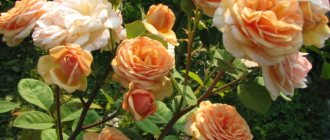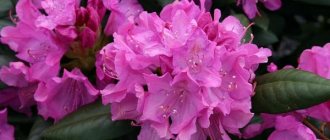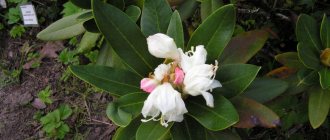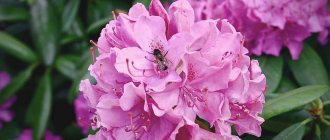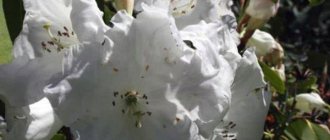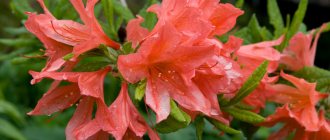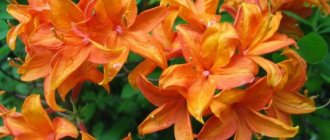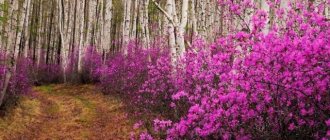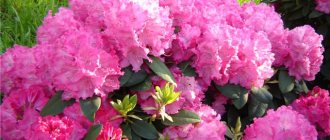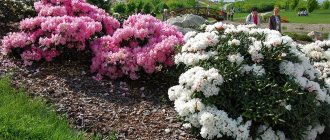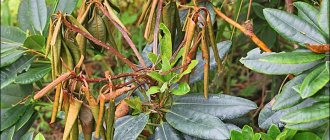Detailed description
- Rhododendron Fantastica is an evergreen low-growing shrub, the height of an adult bush reaches 1 meter.
- The crown grows up to 1.5 m in width. The bush is slow-growing, spreading, cushion-shaped.
- The leaves are long, grow 10–12 cm in length, 5–6 cm in width. They are oblong in shape, bright green, dense in structure.
- The buds are bright red; the flowers become lighter when they open.
- The flowers are variegated, bell-shaped in shape. Up to 7 cm in diameter. The petals are wavy, the flower border is bright pink, the flower itself is white and pink. All the petals of the flower are sprinkled with dots - patterns.
- The inflorescences are spherical, large - unite 10 - 12 flowers.
- The root system is superficial, flat.
LiveInternetLiveInternet
"ROSES" BLOWING IN SPRING
Once you have enjoyed the splendor of rhododendrons in full bloom, you remain a passionate fan of these plants for life. From year to year they never cease to amaze and enchant us with the generosity of their blooms and the unsurpassed variety of shapes and colors of their flowers.
Among cultivated heathers, the first place, both in terms of decorativeness and distribution in our gardens, belongs to rhododendrons. Scottish plant collector Robert Fortune brought these evergreen shrubs to Europe from eastern Asia 160 years ago. Since then, thanks to the tireless work of breeders, much has changed. Never before have rhododendron varieties been as numerous as they are today.
Rhododendrons differ not only in the variety of flower colors, but also in the size and shape of the bush; they are evergreen and deciduous. In autumn, deciduous shrubs display the most vibrant foliage colors: from yellow, orange to fiery red and purple.
Unfortunately, it is now not uncommon for owners of suburban areas, captivated by the beauty of rhododendrons and azaleas, to spontaneously purchase heat-loving hybrid plants brought from more southern regions for their garden. But after some time, bushes planted on the site may completely lose their decorative effect and die.
Hobbie Rhododendron Park. Author PLANTFOTO
The key to success when growing rhododendrons is the choice of species and varieties that are winter-hardy in central Russia, as well as compliance with the general rules of planting and agricultural technology for this crop. Agrotechnical techniques are quite simple and easy to implement, but if, when choosing planting material, you do not take into account the winter hardiness of plants, then all efforts will be in vain. After a harsh winter, the smallest loss is the death of flower buds (sometimes single flowers on the lower branches are preserved), but you can lose the entire bush. To avoid such troubles, you should carefully select planting material. The range of rhododendrons that can withstand the climatic conditions of central Russia is quite large and can satisfy the needs of a wide range of gardeners.
Hobbie Rhododendron Park. Author PLANTFOTO
Below are descriptions of fairly winter-hardy species and varieties of rhododendron that can be recommended for cultivation in central Russia:
DECLIVUS RHODODENDRONS / AZALEAS
1. Species rhododendrons and azaleas.
— Kamchatka Rhododendron (Rhododendron camtchaticum)
Dwarf cushion shrub, slow growing. The maximum height in the culture is 20-30 cm, width - 30-50 cm. The shoots are rough, strongly glandular-hairy when young. The leaves are obovate, up to 2-5 cm long, fresh green, red or yellow in autumn. It is very beautiful during the flowering period - from June - July for more than 20 days. The flowers are dark pink or raspberry-purple, 2.5-5 cm in diameter, with dark specks, solitary or collected in inflorescences of 3-5 pieces.
Frost-resistant species (up to -28C), moisture-loving, light-loving. Recommended for rock gardens, small gardens, ideal in compositions with heather. It is better to plant in sunny places; it prefers well-drained, poor, loose soils with a neutral reaction.
— Pontian azalea (Rhododendron yellow, Azalea pontica, Rhododendron luteum)
Deciduous spreading shrub, 70 cm-2 m tall, growing strongly and reaching a width of 2 meters. The flowers are small, very fragrant, yellow or golden-orange, collected in inflorescences of 7-12 pieces, bloom before the leaves appear or simultaneously with them, in May - June. The leaves are oblong-elliptic and oblong-lanceolate, finely serrated and ciliated along the edges, pubescent on both sides with scattered appressed glandular-bristle hairs. In autumn, the leaves have a beautiful color: yellow, orange, red.
It grows relatively quickly, requires moist soil rich in humus, and does not tolerate dry air. Produces abundant root shoots. Grows in the Caucasus and the Carpathians. One of the most reliable and unpretentious rhododendrons. Grows well in light, on ordinary slightly acidic and neutral soils with the addition of peat or heather soil. The large intraspecific variability of this plant attracts the attention of breeders. Most modern varieties of deciduous azaleas come from the Pontic azalea. Recommended for group and single plantings on the lawn, as well as on the edges.
Lavender Princess (Ph. Lavender Princess) - purple flower caps.
—Japanese rhododendron (Rhododendron Japoniicum)
Deciduous shrub 70-90 cm high. Originally from the Japanese Islands, where it grows on sunny mountain slopes, at altitudes up to 2000 above sea level. The leaves are lanceolate, up to 9-10 cm long and up to 3-4 cm wide. The flowers are funnel-shaped and bell-shaped with a diameter of 6-8 cm, most often orange-red, sometimes yellow, salmon-colored, brick-red, with a pleasant strong aroma. It blooms unusually brightly and profusely in May, with very large flowers, simultaneously with the blossoming of young leaves, for 25 days. It is winter-hardy, unpretentious, and grows well in ordinary moist garden soils to which high-moor peat has been added.
— Canadian Rhododendron (Rhododendron Canadense)
Deciduous shrub 60-80cm high. The flowers are 3-4 cm in diameter, purple-violet, sometimes white, with narrow, intricately curled petals. It blooms in April-May in a leafless state for 20-25 days. Its homeland is the Northeast of North America, where it grows in sphagnum bogs and damp forests. Completely winter-hardy, light-loving. Prefers moist, acidic soils with added peat. It is one of the ten most unpretentious species. Recommended for central Russia.
2. Hybrid deciduous azaleas
A series of hybrid varieties descended from the Pontian azalea (Azalea pontica). They are shrubs 1–1.5 m tall and wide. The flowers are very brightly colored: white, yellow, orange, red, pink. They bloom at the same time or before the leaves bloom. Winter-hardy, can withstand temperatures down to -29 C.
Varieties:
Cecile (Rh. Cecile) – Upright growing shrub with a spreading crown, 1.5-2 m high. Slow growing. flowers in buds are pink, after blooming they are light pink. More resistant than evergreen species. Recommended: sheltered from the wind, rich, moist soils, sensitive to drought. You should avoid loosening the tree trunk and remove faded inflorescences. It is advisable to cover for the winter and mulch. Winter hardiness zone 5;
Coccinea Speciosa (Rh. Coccinea Speciosa) – The flowers are small, orange with narrow petals. A slow-growing strictly vertical shrub with a height and width of 1.5-2 m; old plants have an asymmetrical funnel-shaped shape. Winter hardiness zone 5;
Daviesii (Rh. Daviesii) – The flowers are creamy white with yellow speckles. Winter hardiness zone 5;
Fireworks (Rh. Feuerwerk) – Flowers are orange-red or bright red. Winter hardiness zone 5;
Fireball (Rh. Fireball) – The flowers are deep red. Zone 5;
Gibraltar - Flowers intense orange. Zone 5;
Homebush (Rh. Homebush) – Flowers are carmine pink, with narrow petals. Winter hardiness zone 5;
Juanita (Rh. Juanita) – The flowers are deep pink with orange spots. Winter hardiness zone 5;
Klondike (Rh. Klondyke) – Flowers are golden yellow or yellow-orange. Winter hardiness zone 5;
Persil (Rh. Persil) – Snow-white flowers with bright yellow specks. Winter hardiness zone 5;
Satomi (Rh. Satomi) – The flowers are soft white and pink. Winter hardiness zone 5;
Anneke (Rh. Anneke) - Winter hardiness zone 5;
Cannon's Double (Rh. Cannon's Double) - Winter hardiness zone 5;
Fanal (Rh. Fanal) - Winter hardiness zone 5;
Fashing (Rh. Fasching) - Winter hardiness zone 5;
Nabucco (Rh. Nabucco) - Winter hardiness zone 5;
Silver Slipper (Rh. Silver Slipper) - Winter hardiness zone 5.
EVERGREEN RHODODENDRONS AND AZALEAS
1. Large-flowered hybrid varieties
Cunningham's White (Rh. Cunningham's White) - A popular variety from the hybrid group of Caucasian rhododendron species (probably Caucasian rhododendron and the white-flowered form of Pontic rhododendron), bred in 1850 by D. Cunningham. An evergreen shrub up to 2 m high. The buds are pinkish, the flowers are up to 7 cm in diameter, white with a yellowish-green spot. It blooms from the first ten days of May to mid-June. Winter hardiness zone 5, can withstand frosts down to -24 C without shelter;
Roseum Elegans (Rh "Roseum Elegans") - A hybrid of Katevbinsky rhododendron, obtained by A. Waterer in England in 1851. Evergreen, vigorous shrub up to 3 m tall. Annual growth is up to 15 cm. The crown is wide-rounded, closed below. The leaves are leathery, oval or narrowly elliptical, shiny, 7 - 8 cm long, 5 - 6 cm wide, often reddish-brown when blooming, then dark green. The flowers are pink with a reddish-brown spot, 7 cm in diameter, widely funnel-shaped, collected in inflorescences of up to 15 flowers, the petals are slightly wavy along the edge. Blooms in June. Winter-hardy provided the plants are planted in places protected from the wind. Withstands frosts down to -27 C. Planted singly on the lawn, in groups against the background of coniferous or deciduous trees. It lives in cultivation for a long time, prefers fertile, slightly acidic soils, and tolerates slight shade. Winter hardiness zone 5;
| Rhododendron Nova Zembla | Rhododendron katevbinskiy Grandiflorum |
Liz Dark Purple (Rh. Lee's Dark Purple) - Shrub 1.5 m high, grows greatly in width. The foliage is shiny, dark green. The flowers are dark, purple-violet with a dark yellow spot, 4.5 cm in diameter, large, showy, opening in June. Winter hardiness zone 5, tolerates frosts down to -26C.
Blue Peter (Rh. Blue Peter) - The variety was bred in 1933 by the English breeder A. Waterer. The flowers are 4.8 cm in diameter, light lavender blue with a dark red spot on the upper petal inside the flower. The edges of the corolla petals are slightly corrugated. Inflorescences are compact, with 20 or more flowers. Blooms in late May-June. The leaves are evergreen, large. Moderately growing shrub with a wide, spreading crown, 1.2 m high. Requires a more protected location, can withstand temperatures down to -26 C;
| Rhododendron Calsap | Rhododendron Yakushiman Arabella |
Nova Zembla (Rh. Nova Zembla) - The variety was obtained at the beginning of the 20th century in the Netherlands. Tall shrub with a wide crown. The leaves are leathery, large, oblong-elliptic, up to 16 cm long and up to 5 cm wide, dark green above, shiny, glabrous, lighter below. The flowers are large, shiny, crimson-red with black specks, collected in compact inflorescences of 10 - 12 pieces. Blooms from late May to the second half of June. Tolerates frosts down to -29 C. Winter hardiness zone 5a. Planted singly or in groups on the lawn, along the road, at the edge of deciduous and coniferous trees, in places protected from the wind.
2. Species of rhododendrons and their varieties
— Rhododendron catawbiense (Rhododendron сatawbiense) Evergreen shrub about 1-2 m high. Elliptical leaves 6-12 cm long, leathery, shiny. The flowers are reddish-lilac or purple, about 5 cm in diameter, collected in dense multi-flowered inflorescences of 15-20 pieces. It blooms in May-June for about a month. Due to its unpretentiousness and winter hardiness, it is the most popular of the evergreen rhododendrons. Tolerates full sun, but grows best in diffuse or lateral partial shade. Prefers acidic, moist peaty soils. It has many varieties, including hybrids, from crossing with other evergreen species of rhododendrons.
Varieties:
Al-boom Elegance (Rh. Album Elegans) - ,
Album Novum (Rh. Album Novum) - ,
Cataractus (Rh. Caractacus) -,
Grandiflorum (Rh. Grandiflorum) -,
Purpureum Elegans (Rh. Purpureum Elegans) -,
Purpureum Grandiflorum (Rh. Purpureum Grandiflorum) - Spreading hemispherical shrub. It blooms with purple-lilac flowers with a greenish spot, collected in inflorescences of 15 pieces. Flowering from early June. Winter hardiness down to -30 C.
Roseum Elegans (Rh. Roseum Elegans) - Pink flowers with a reddish-brown spot. Withstands frosts down to -27 C.
Grandiflorum (Rh. Grandiflorum) - Obtained in England at the beginning of the 19th century as a result of selection from Katevbinsky rhododendron seedlings. One of the tallest varieties. Annual growth in height is up to 12 cm. The leaves are dark green, 10-15 cm long. The flowers are 6-7 cm in diameter, lilac-lilac with golden-brown specks and a greenish-yellow spot, odorless, collected in inflorescences of 13 -15 pieces, bloom in May-June. Very winter hardy. Without shelter, adult plants can withstand temperatures as low as -32 C. It is better to plant them in semi-shaded places protected from the wind - singly or in groups on the lawn.
Boursault (Rh. Boursault) - The variety arose as a result of the selection of Katevbinsky rhododendron. The flowers are 5 cm in diameter, violet-lilac with a pink tint, have a greenish-yellow spot on one of the corolla petals, and open in June. The flowers are collected in a compact inflorescence containing up to 15 flowers. Young leaves are yellow-green, darkening with age. Winter-hardy down to -27 C. It is recommended to plant in semi-shaded places protected from the wind.
Short-fruited (Rh. brachycarpum) is an evergreen shrub 150-200 cm high with a dense spherical crown. The leaves are large, 8-20 cm long, oblong-elliptic, leathery. The flowers are creamy-white with a pinkish tan, wide funnel-shaped, 4-5 cm in diameter, collected in dense racemes of 12-20 pieces. Blooms in June-July for 15-20 days. One of the ten most winter-hardy evergreen rhododendrons. Light-loving, but grows well on the north side of buildings and in mesh partial shade. Thanks to its dense decorative crown, it is attractive from early spring until frost. It is even suitable for public landscaping. It is especially desirable for landscaping yards, where it can become the first truly evergreen shrub. With its presence, it enlivens flower and shrub compositions and introduces a subtropical flavor unusual to the eye. Prefers light, well-drained, humus-rich, acidic sandy loam soils.
Hague (Rh. Haaga) - The color of the flower is dark pink. Frost-resistant, withstands frosts down to -36 C.
Helsinki University (Rh. HelsinkiUniversity) - The most famous hybrid of Finnish selection. Winter-hardy down to -39 C. Also able to withstand high humidity and temperature changes. Shade-tolerant, 120 cm high. Blooms from June with light pink flowers with an orange spot on the upper petal and dark burgundy specks on top of it. In inflorescences there are 12-18 pieces.
P.M.A. Tigerstedt (Rh. R.M.A. Tigerstedt) - ;
Mikkel (Rh. Mikkel) - ;
Rekka (Rh. Rekka)— ;
Elvira (Rh. Elviira)— ;
Hellikki (Rh. Hellikki)— .
— Rhododendron yakushimanum (Rhododendron yakushimanum) Slow-growing compact, spherical shrub, 0.5 -1 m high, crown diameter up to 1.5 m. Leaves are elongated, 5-10 cm long, 3-4 cm wide, leathery, dark green above, below with dense dark brown felt pubescence. Flowering is abundant and long, from May to early June. The flowers are initially pale pink, later white, up to 6 cm in diameter, collected in 6-12 pieces. Photophilous. Prefers soils that are fresh, peaty, rich in humus, slightly acidic or acidic. It is winter-hardy, withstands winter frosts down to -22-26 C depending on the variety, but at a young age it is better to cover the plants. Recommended for rock gardens, group plantings in rocky gardens.
Varieties:
Almut (Rh. Almut) - White flowers;
Anushka (Rh. Anuschka) – The flowers are intense pink, pinkish-white inside;
Arabella (Rh. Arabella) – The flowers are red, white inside, pink ruffled edge;
Astrid (Rh. Astrid) – The flowers are bright red;
Balkenegin (Rh. Ballkonigin) – Rose-red buds, light pink flowers;
Bluretti (Rh. Blurettia) – Purple-pink flowers with a ruffled edge;
Edelweiss (Rh. Edelweis) – Light pink buds, white flowers;
Feling Snow (Rh. Falling Snow) – Light purple buds, white flowers;
Fantastica (Rh. Fantastica) – The flowers are red on the outside, light pink on the inside;
Flava (Rh. Flava) – Golden yellow buds, light yellow flowers;
Kalinka (Rh. Kalinka) – Evergreen shrub of hemispherical shape. Reaches 90 cm in height and 130 cm in width. The leaves are dark green and shiny. The flowers are first red in buds, later ruby-pink, gradually becoming lighter, with a yellow-green pattern. Winter hardiness down to -26C.
Koichiro Wada (Rh. Koichiro Wada) – The flowers are soft pink and white;
Marrakech (Rh. Marrakesch) – Light salmon flowers;
Polaris (Rh. Polaris) – Carmine buds, ruby pink flowers, light pink inside;
Schneekrone (Rh. Schneekrone) – Soft pink buds, brown flowers;
Silberwolke (Rh. Silbrwolke) – Pink buds, white flowers with yellowish specks;
Silver Lady (Rh. Silver Lady) – Pinkish-red buds, white flowers;
Tatyana (Rh. Tatjana) – Flowers intensely carmine-pink, ruby inside, corrugated
— Carolina rhododendron (Rhododendron carolinianum) An evergreen shrub 1–1.5 m high. The crown is wide-rounded. The bark is light brown. The leaves are elliptical dark green, 6 -10 cm long, 3 - 4 cm wide, glabrous above, densely covered with scales below. It blooms in May–June for about 3 weeks. The flowers are white or pink, about 3 cm in diameter, 4 - 9 in an inflorescence, funnel-shaped, with a yellowish spot. Grows slowly, annual growth is about 5 cm. Photophilous. Prefers slightly acidic, light, moist soils. High winter hardiness. In gardens they are planted in groups and singly in rocky areas.
In the USA, based on the Carolina rhododendron, E. Mesitt produced a group of winter-hardy honeycombs:
P.J.M.Elite (Rh. PJM.Elite) – The flowers are pink-purple, blooms in May. It is characterized by high winter hardiness. Winter hardiness zone 4. Withstands frosts down to -35 C;
P.J.Mezitt (Rh. PJMezitt) – Purple-pink flowers. Winter-hardy;
Regal (Rh. Regal) - The flowers are purple-red. Winter-hardy;
Victor (Rh. Victor) - The flowers are lilac-pink.
| Rhododendron P.J.M.Elite | Rhododendron Helsinki University |
— Dahurian rhododendron (Rhododendron dahuricum) Deciduous, but sometimes part of the leaves at the top remains to overwinter on the plant, a highly branched shrub from 70 cm to 2 m in height. The leaves are small, elliptical, densely covered with glands. The flowers are pink in various shades, rarely white, up to 4 cm in diameter. It blooms from late April to May until the leaves bloom. The undoubted advantage of the species is its high winter hardiness down to -32 C, but it can suffer from late spring frosts during flowering. It grows well in ordinary garden soil if you add high-moor peat to it. In nature, this species is widespread in the south of Eastern Siberia and the Far East. It is this one that is most often called “Ledum”. Recommended for growing on the edges and in small groups under the canopy of light conifers, such as larches.
Varieties:
— April Rose (Rh. April Rose) – The flowers are purple-pink, double. Winter hardiness zone 5;
— Double White (Rh. Double White) – The flowers are white, double. Winter hardiness zone 5;
— April Gem (Rh. April Gem) – The flowers are white, double. Winter hardiness zone 5;
— April Reign (Rh. April Reign) – The flowers are light pink, double. Winter hardiness zone 5;
— Rusty rhododendron (Rhododendron ferrugineum).
Slow-growing, low, cushion-shaped shrub. Height 0.7 m, crown diameter up to 1 m. The bark is grayish-brown. The leaves are leathery, ovate, 3-4 cm long, up to 1.5 cm wide. Dark green, shiny above, with rusty scale-like glands below. Flowering lasts from late May to late June for about 30 days. The flowers are pink-red, rarely white, up to 2 cm in diameter, collected in inflorescences of 6-10 pieces. Photophilous. Tolerates calcareous soils, but covered with a thick humus layer, preferably acidic (pH 4.5). Quite winter hardy. Alpine slides, single and group plantings on the lawn with rusty rhododendron will decorate any garden.
Varieties:
– Tottenham (Rh. Tottenham) – Plant height is about 30-40 cm, pink flowers, winter hardiness zone 5.
— Rhododendron impeditum
An evergreen, very dense, low cushion-shaped shrub, in nature and culture from 0.1 to 0.7 m tall. The shoots are short, densely covered with black scales. The leaves are small, broadly elliptical, 1.5–2.0 cm long, up to 1 cm wide, scaly on both sides. The flowers are small, violet-blue, 2.0-2.5 cm in diameter. It blooms in May - June, often again in August - September. One of the most valuable small-leaved and small-flowered evergreen species of rhododendron. Grows best in rich, fresh or moist soils. Light-loving, but tolerates slight shading. Mature plants overwinter under the snow, are quite winter-hardy, and bloom profusely every year.
Single or group plantings are recommended for low rocky areas and alpine hills, in clumps on lawns, and in borders.
Varieties:
Azurika (Rh. Azurika) – Flowers dark blue-violet, winter hardiness zone 5;
Blue Tit (Rh. Blue Tit) - Tall variety, 1 m in height, blue flowers. Winter hardiness zone 5;
Blue Tit Magor (Rh. Blue Tit Magor) – Height up to 1.2 m, flowers are large, light purple-blue. Winter hardiness zone 5;
Moerheim (Rh. Moerheim) – Purple flowers. Winter hardiness zone 5;
Ramapo (Rh. Ramapo) – Dense, compact shrub 60 cm high. Blooms with lilac flowers, collected in inflorescences of 15 pieces. Flowering from mid-May. Winter hardiness down to -29C. Winter hardiness zone 5;
Luisella (Rh. Luisella) – The flowers are light purple-pink. Winter hardiness zone 5.
— Small rhododendron (Rhododendron minus)
An evergreen rounded shrub with a dense crown, up to 1 m high, up to 1.5 m wide. Leaves are dark green, elliptical, leathery, shiny, 4-10 cm long. Flowers with a diameter of 2.5-3 cm are pale pink or carmine pink. , collected in inflorescences of 10-15 pieces, blooms in June, prefers slightly acidic, rich soils and a bright location. Frost-resistant, it is recommended to cover young plants for the winter.
— Rhododendron russatum
Evergreen cushion-shaped shrub, up to 1 m high, crown diameter up to 0.8 m. Grows slowly. The leaves are small, lanceolate, up to 3 cm long, dark green above, reddish-brown below, densely scaly. Blooms in May for 25 days. The flowers are dark purple with a white throat, up to 2.5 cm in diameter, odorless, collected in 4 - 5 pieces. Photophilous. Prefers acidic, moist, well-drained soils. Overwinters with light shelter. One of the most beautiful abundantly and annually flowering ornamental shrubs. Used in rock gardens.
Varieties:
— Lauretta (Rh. Lauretta) – violet-blue flowers;
— Azurvolk (Rh. Azurwolke) – flowers are bright deep blue, winter-hardy;
— Blaufeder (Rh. Blaufeder) – the flowers are bright blue-violet.
Growing rhododendrons, soil, planting and care
The smoke and gas resistance of some rhododendrons allows them to be used in landscaping cities and industrial enterprises. They release essential oils and phytoncides into the environment, thereby purifying the air of pathogens and contributing to a healthier environment.
Rhododendron can be planted as a single bush on the lawn or under the canopy of trees. You can plant them in groups at the edge of the forest and in rows along the paths of a park or square. They will look great in compositions on alpine hills, in “Japanese gardens”, in single and group plantings, hedges, decorative compositions in gardens, parks, public gardens, forest parks. They are perfect for landscape design of public buildings (hotels, offices, lobbies, theater foyers, etc.) and winter gardens. This plant will decorate a heather garden. It can be used to create beautiful low-growing and medium-height borders. Rhododendron is also suitable as a ground cover plant.
The soil
Rhododendrons prefer loose, humus-rich, water- and breathable acidic (pH 4.2 - 5.5) soil. It is advisable to add pine litter and finely crushed pine bark to it. Since these shrubs do not tolerate stagnant water, drainage must be laid at the bottom - broken brick or sand, fine gravel in a layer of 15-20 cm.
Location
When choosing a planting site, the best option would be light partial shade, which is created by large trees in the garden. Avoid the sun and open areas where cold winds blow. The most favorable time for planting rhododendron is spring, and also starting in September. When choosing a place to plant rhododendron, pay attention to what neighboring plants will surround your “pink tree”. The fact is that rhododendrons have a very compact and shallow root system. Thus, a bush with a crown size of more than a meter and a height of 1.2 m turned out to have a root system with a diameter of only 35-40 cm. Therefore, if among the neighbors of the rhododendron there are plants with a superficial root system (birch, oak, tall maple, willow, etc. .), then they will quickly “take” all the nutrients from the soil.
The most successful neighbors for rhododendron are larches, spruce and pine trees - that is, those plants under which rhododendrons grow in nature. The planting hole, which should be 3-4 times wider and twice as deep as the size of the seedling’s earthen ball, is filled with a mixture: soil removed from the hole and peat soil in a 1:1 ratio.
Before planting, remove the rhododendron bush from the pot and shake the root system a little with your hands so that the roots “understand” that they are planted in a new spacious place from a cramped pot. If the roots and peat are intertwined in such a way that it is impossible to do this with your hands, then you should try to cut the root ball in several places with a knife.
Remember that these shrubs have a compact and shallow root system. When planting rhododendron, you should not bury the root collar, otherwise the seedling will not be protected from rotting, which leads to death. When planting plants, you need to ensure that their root system is 2-4 cm higher than the soil level, taking into account its precipitation. After planting, the bush is watered, and the soil around it is mulched with peat, pine litter or crushed bark 3-5 cm thick. Mulching not only prevents moisture evaporation, but also maintains the desired acidity of the soil.
If you choose the right place for rhododendrons, carefully prepare the soil and mulch the tree trunks, then their care is minimal. In spring, it is useful to feed adult bushes with ammonium nitrate or ammonium sulfate, superphosphate (20-50 g per 1 m2). If the site has loamy and sandy loam soils, then spring fertilizing is combined with light acidification of the soil with a weak solution of oxalic or citric acid (3-4 g per bucket of water).
When the leaves become soft and slightly shiny in the heat, the plants need to be watered abundantly. The root ball should not be allowed to dry out.
It is better not to overuse rhododendron pruning; only in the most extreme cases, sanitary pruning is carried out after flowering.
Care
Weeding of tree trunks, watering and fertilizing. For normal growth and development of plants, the soil should be fertilized three times per season: 1 - before flowering, 2 - immediately after it, 3 - in late July-early August. During the first two feedings, about 20-30 g of special instant fertilizer for rhododendrons or 2-3 g of Kemira Universal per 1 liter of water are applied to each plant. Add 5-10 g of urea or any other nitrogenous fertilizer to each portion.
During the third feeding, 30 g of superphosphate and 15 g of potassium sulfate are added to each bush and some complex fertilizers with microelements. Completely exclude nitrogen from the last feeding and reduce the proportion of microelements. This composition promotes the ripening of rhododendron wood and prevents the growth of shoots, which can happen in a warm autumn.
Twice a year (in spring and at the end of August) the soil under rhododendrons is mulched with pine sawdust, peat, pine litter or crushed bark in a layer of 3 - 5 cm - this protects it from rapid drying out, the appearance of weeds and maintaining soil acidity. Water the soil regularly throughout the season, abundantly in dry and hot times of the season, 10 - 12 liters per plant 2-3 times a week. Spray plants whenever possible, especially during active growth. The surest sign of water deficiency is that the leaves become dull and droop, with brown spots appearing along their edges, similar to fungal diseases. Ideally, water for watering Rhododendrons should be soft (rain or snow) and acidic, and should not contain a lot of salts. In the first year after planting, it is better to break off all the buds so as not to weaken the fragile plant (leave a couple if you are eager to make sure that you have chosen exactly the variety you wanted). In adult plants, after flowering, only a part of the well-developed fruits is left for collecting seeds; excess fruits are removed, which contributes to better flowering of the plants next year.
Preparing rhododendrons for winter
For successful overwintering, you need to water the bushes abundantly before the start of winter, before the soil freezes. In the first 2-3 years after planting, it is recommended to cover evergreen rhododendrons with spruce branches, low-growing rhododendrons with a completely dry oak leaf, more heat-loving varieties can be covered with burlap, which is stretched over the frame. For deciduous rhododendrons, bending branches to the ground is used so that they are covered with snow in winter. At the end of April - beginning of May, the cover is removed gradually, first by ventilating the bushes, then on a cloudy day, the entire frame is removed, leaving the spruce branches to avoid spring sunburn. And after a few more days you can remove it too. Compliance with these requirements, as well as regular fertilizing with special fertilizers for rhododendrons, will help to obtain excellent flowering and healthy bushes.
Reproduction
Rhododendrons can be propagated both by seeds and vegetatively (layering, cuttings). Wild species are usually propagated by seeds, and varieties are most often propagated by layering and cuttings.
Diseases and non-infectious lesions characteristic of them can prevent the full development of rhododendrons.
But more on that next time.
Information from the website “Magic of Nature”: https://magia-naturalis.ru/page-66.html
and the website Garden Center Paer+: https://www.paer.ru/stati_i_sovetyi/rododendronyi_vyibiraem_zimostoykie_vidyi_i_sorta/
Series of messages “garden”:
Part 1 - Forming fruit trees. Palmette - what is it? Part 2 - Schemes for palmette formation from Para SOL kA. ... Part 9 - Tree peonies of Russian selection. Varieties of Marianna Uspenskaya. Part 10 - Luxurious hydrangea. Story. Kinds. Care. Part 11 - Rhododendrons. Winter-hardy varieties. Part 12 - Diseases of rhododendrons. Prevention and treatment measures. Part 13 - Spring concerns of a florist. Dangers. Flower tips. ... Part 21 - Plant compatibility when landscaping a site Part 22 - Peonies are in fashion trend! The main color of 2021! “Living Coral” is embodied in flowers. Part 23 - Peonies. If you want flowers, feed them.
Series of messages “landscape design”:
Part 1 - Tree peonies of Russian selection. Varieties of Marianna Uspenskaya. Part 2 - Luxurious hydrangea. Story. Kinds. Care. Part 3 - Rhododendrons. Winter-hardy varieties. Part 4 - Diseases of rhododendrons. Prevention and treatment measures. Part 5 - Spring concerns of a florist. Dangers. Flower tips. ... Part 12 - Botanical watercolor. illustrations by Eunike Nugroho. Part 13 - Plant compatibility when landscaping a site Part 14 - Peonies. If you want flowers, feed them.
Sub-varieties
Kalinka
An adult bush reaches about 2m. Resistant to frost, can withstand temperatures up to 23 – 25 °C. It is usually covered for the winter. Kalinka blooms in a soft pink color with a lilac tint . The inflorescences are lush, spherical, containing up to 12–15 flowers.
Percy Weissman
Compact evergreen bush, grows up to 1.5 m in diameter. It is small in height, reaching 1 m. The flowers are pale pink, with a peach tint - blush around the edges. At the end of flowering, they fade under the sun and become golden-white.
Top ten varieties
There is a wide selection of varieties of Yakushiman rhododendron, each of which differs in external characteristics. Thanks to this, you can select and plant one that is suitable for decoration in the garden. Below is a description of ten popular varieties of this crop.
Golden Torch
Golden Torch is a non-deciduous, compact bush , with a wide, rounded crown, up to 1.2 m high, with a slow seasonal growth of about 8 cm. The foliage is ellipsoidal, 7–10 cm long, crowded, dark emerald in color.
The ovaries are pink, the flowers are creamy-white or yellow-white, cone-shaped, with wavy edges. They bloom profusely and bloom in mid-May. It has high winter hardiness - down to –29°C. Loves sunny places with light partial shade, does not tolerate strong winds.
Bluretta
Blurettia is a slow-growing shrub with a low, dense, dome-shaped crown, up to 90 cm in size, about 1.3 m in diameter. The inflorescences are large, spherical, pink-violet in color, with a wavy purple edge. The leaves are green, oval, glossy, slightly curved. Withstands frosts down to –23°C, grows well in partial shade.
Kalinka
Kalinka is an evergreen plant , with a dense spherical crown, up to 1 m high, 1.2 m wide. The ovaries are crimson or carmine-red, the flowers are ruby pink or lilac pink, conical, large, 6.5–7 in diameter .5 cm, the edges of the petals are wavy, flowering begins at the end of May. The leaves are elongated, leathery, shiny, rich green above, light green below. Easily tolerates sunny places and heat.
Brazil
Brasilia is a compact, non-deciduous shrub , with a columnar crown up to 1.1 m high and 1.2 m wide. The leaves are large, shiny, dark green in color.
The flowers are a soft peach or yellow-pinkish hue, the petals are delicate, finely speckled, with pink corrugated edges. The inflorescence contains 12–15 flowers and blooms profusely from May to the end of June. Frost-resistant (down to –24°C). Prefers to grow in partial shade.
Lorelei
Loreley is an evergreen, slow-growing variety , shrub height is 0.8–1 m, the crown is oval, up to 1 m in diameter. The leaves are elliptical with a sharp tip, glossy, dark green, pale green below.
The buds are pink, the inflorescences are light pink when they bloom, lighter in the middle, with ruffled edges of a deep pink color. Average winter hardiness (down to –22°C).
Lichtfire
Leuchtfeuer is a non-deciduous shrub , with a wide, spherical crown, 1.1 m in size, up to 1.5 m wide. The leaf blades are emerald green, glossy, leathery, oval.
Did you know? In Japan,
rhododendron is called the “flower of temptation.”
Honey from the nectar of some of its varieties contains the substance andromedotoxin -
it excites the nervous system, leading a person to a state similar to intoxication.
The branches are large, up to 8.5 cm, collected in inflorescences of 10–15 pieces, bright red, the edges of the petals are wavy. They begin to bloom in early May and bloom generously. Prefers to grow in partial shade, winter hardiness is average (down to –22°C).
Rose Wolke
Rosa Wolke is a medium-sized evergreen variety , the crown of the bush is spherical, spreading up to 1.2 m, seasonal increase is 10 cm. The leaves are dense, elongated, rich emerald color.
The flower ovaries are pink, the flowers are light pink, bell-shaped, with double reddish edges, arranged in brushes of up to 15 pieces, bloom profusely, flowering period is May-June. Withstands frost down to –22°C.
Did you know? from
rhododendron arboreum (wood) flowers, they are pickled, dried and used as a seasoning for fish dishes.
Lumina
Lumina is a low and non-deciduous, compact shrub , up to 90 cm high, up to 1.5 m in diameter. The leaves are large, dense, elongated, 5–10 cm long.
Flowers are 4–6 cm wide, from pink-lilac to pink-ruby color, delicate petals with wavy edges, spherical inflorescences. Flowering is generous, begins in May, lasts about 30 days. The variety is resistant to diseases. High frost resistance (up to –26°C).
Mix
Si Gemengd is an evergreen shrub , crown height up to 2.2 m, with blue, pink, white large flowers, collected in brushes of 5–8 pieces, the petals are delicate, corrugated along the edge, bloom wildly. The foliage is dark green in color, leathery, oblong in shape, the lower part is pubescent.
Hummingbird
Colibri is an evergreen, slow-growing variety , the shrub grows by 5 cm per year. The crown is spherical, compact, 0.8 m high, spreading up to 1.2 cm. The leaves are oval, long, with a slight convexity, the length of the plate is up to 10 cm , dark green, shiny.
See rhododendron planting patterns for landscape design.
The flowers are soft pink with white splashes, decorated with a pink pattern on the outside, and bloom in May. Frost resistance is average (up to –22°C), easily tolerates partial shade. Requires shelter for the winter.
Care before and after
For good growth and flowering, it is necessary to fertilize Rhododendron Fantastica before flowering and immediately after the inflorescences wither, in a ratio of 15 - 20 g of special fertilizer per 1 liter of water. Immediately after flowering, faded flowers are removed to lay new flower buds.
What to do if this doesn't happen?
- In order for the flowering to be lush and long-lasting, it is necessary to cut off the faded buds.
- If planting is incorrect - the roots are too deep, flowering does not occur and replanting is required.
- Weeds, garden pests, old branches and dead wood also prevent flowering.
Selection of location and soil
Rhododendron Fantastica is best planted on the southwestern side of the site . A prerequisite is protection from wind and direct rays. This variety prefers semi-shaded planting sites. These hybrids cannot be planted next to fruit and berry bushes and trees due to the structural features of the surface root.
The soil for the Fantastica variety should be moist, light, loose, and acidic, so the basis of the soil mixture should be acidic peat.
Composition of the substrate for rhododendron Fantastica:
- Sour peat – 2 hours.
- Sawdust - 1 tsp.
- Sand – 1 hour.
- Drainage base.
Sawdust in the soil can be replaced with leaf or coniferous soil in the same proportions. The soil circles near the trunk cannot be loosened; weeds are removed by hand.
Conditions for growing the rhododendron variety Fantastica
The plant prefers shaded areas and does not tolerate direct sunlight. The photos taken by gardeners about planting and caring for the Fantastic rhododendron show that it feels good under conifers - not very dense pine and spruce trees, in the shade of forest areas. Territories exposed to winds and drafts are dangerous for culture.
Plants tolerate drought and excessive waterlogging equally poorly; they need regular watering.
The soil should be acidic, fertile, loose, sandy loam.
The best time to plant rhododendron Fantastica is in mid-spring, after the soil has thawed and warmed up, or in September, before frost sets in.
Do not bury the root neck, otherwise the plant may rot.
It is possible to arrange rhododendrons of the Fantastica variety on the site in individual bushes or in the form of group plantings.
Planting
Rhododendron Fantastica is best planted in a flowerbed or front garden in mid-April, but it can also be done at the very beginning of May. Planting requires preparation and consistent actions:
- The required substrate is pre-prepared.
- The depth of the planting hole is at least 40 cm, width 60 - 70 cm.
- A layer of expanded clay, 10–15 cm thick, must be laid on the bottom.
- Any material that does not contain calcium is used as drainage.
- The planting seedling needs to be thoroughly soaked and immersed in water for 20-30 minutes.
- The bush is placed vertically in the hole, deepening it to the level of the root collar.
- You can feed the seedlings with mineral fertilizers and sulfur for better rooting.
IMPORTANT : Planting seedlings require good moisture. Do not add humus, manure or ash to the substrate.
Watch a video about the rules for planting rhododendron:
Temperature
Rhododendron Fantastica is resistant to temperatures down to -26 ° C, but is susceptible to gusty winter winds . If frosts in the region are higher than the permissible norm for this variety, shelter is required.
It is better to move flowers growing in pots and boxes for the winter to a cool cellar, heated loggia or closed balcony. The optimal temperature for keeping the Fantastica rhododendron at rest is 0 – 5 °C.
Watering
In spring and summer, rhododendron Fantastica is watered abundantly 2 - 3 times a week. Each adult bush requires 8 - 10 liters of water.
- Young flowers are watered every other day, watering doses are reduced by 2 times.
- In extreme heat, morning spraying of the bush is required to maintain the balance of air humidity.
- In autumn and winter, watering should be rare; care must be taken to ensure that the substrate does not dry out.
Top dressing
Fertilize rhododendron Fantastica in spring or July . It is necessary to use organic fertilizers that do not contain chlorine and lime.
Can be fertilized with complex mixtures:
- Magnesium – 2 hours.
- Potassium – 4 tsp.
- Ammonium sulfate – 9 tsp.
- Potassium superphosphate – 10 tsp.
Trimming
Pruning is done to form the correct crown shape . The procedure is carried out on a three-year-old bush; it is not recommended to prune very young flowers. Old branches of an adult bush are cut off. Sections should be treated for disinfection with oil paint or garden varnish.
For young bushes, in order for the bush to branch well, pinching the tops of the shoots is required.
Transfer
The hybrid is replanted only when the soil warms up, in April - May . You can replant the bush in September, before frost. Rhododendron Fantastica can be replanted at any age. When replanting, you should save the earthen lump due to the fragile root.
It is necessary to mulch the substrate with a mixture of pine needles, peat, sawdust, and medium-sized pieces of pine bark. The mulch is periodically updated - added every autumn before wintering. The mulch layer is at least 5–6 cm.
How to prepare for winter?
Rhododendron Fantastica curls its leaves into a tube in winter . To prevent the bush from being damaged by frost and wind, it is better to tie it with twine and make insulation from spruce branches in the middle of the bush. All this is necessary, since the plant has low winter hardiness. It is not necessary to cover an adult bush.
TIP : Young bushes of rhododendron Fantastica are covered for the winter with dry spruce branches or burlap.
Rhododendron Yakushimansky - planting and care
This plant has good winter hardiness , therefore it is recommended for cultivation in the central zone of our country.
It is important to remember the maintenance rules, because improper care can destroy the shrub.
Planting
The best time to plant Yakushiman rhododendron is the end of April , when the soil is completely warmed by the sun. You can also plant in the fall, at the beginning of September, when there are no frosts yet.
Azalea does not tolerate direct sunlight . place exposed to winds will also be a dangerous place for it The best location is partial shade .
When planting, you should not deepen the root neck, otherwise the seedling may rot . It is necessary to ensure that the root system is 3-4 cm above the soil.
You can plant rhododendron as a separate bush, or you can create a group composition. Such evergreen shrubs will decorate the garden.
Priming
Azaleas prefer loose, acidic, humus-rich soil. You can prepare the soil yourself. To do this, you need to take two parts of peat soil, two parts of coniferous soil and one part of river sand. When planting, it is advisable to place drainage (expanded clay, pebbles, sand) at the bottom of the hole to avoid stagnation of water.
Watering
Rhododendron Yakumashinsky is moisture-loving, so it is important to monitor the amount of watering. Watering is done 2-3 times a week; in dry weather, spraying is recommended.
Temperature
Frost resistance is a characteristic feature of this plant. It can withstand cold temperatures down to -30 C. But it should be remembered that young seedlings need to be covered for the winter.
Fertilizer and feeding
For proper growth, rhododendron should be fertilized 3 times per season. The first time - before flowering (20 grams of fertilizer for feeding azaleas per liter of water), the second time - immediately after it (with the same fertilizer), the third time - at the end of August (25 grams of superphosphate and 15 grams of potassium sulfate). The third feeding is necessary to ripen the bark and prevent the formation of young shoots.
Bloom
The flowering of Rhododendron Yakushimanensis is unusually beautiful and abundant. Flowers collected in inflorescences sprinkle the entire bush. It begins at the end of May and continues until the end of June.
Trimming
This plant does not require special pruning. But there are situations when it is important to do this, such as removing dead wood and dead branches.
After flowering, it is recommended to cut off spent blooms for a variety of flowers next year.
Transfer
Transplanting azaleas is often painless at any age, but you should remember that you should not disturb the earthen ball so as not to damage the root system. The best time to transplant is spring and autumn.
Reproduction methods
There are several ways to choose which one to choose - each gardener decides for himself.
Seeds. Seeds are planted in January-February. Sowing occurs superficially in nutritious soil. Shoots appear within a week.
Seedlings are planted in a permanent place of growth only after a year .
By cuttings. To obtain cuttings, you need to cut a branch 5 cm in size and having 3-4 internodes. The cuttings are placed in peat-sand soil. Within a month, rooting occurs and shoots and leaves appear.
By layering. For this method of propagation, in the spring, select a lower branch, cut it slightly and immerse it under the soil. It is important to water the cuttings and sprinkle them with nutritious soil. By mid-July, the cuttings will take root and can be cut off from the mother bush and transplanted to another place.
By division. An adult bush is dug out of the ground and divided into parts. Each part is planted separately. After 2-3 years, the bush will completely recover and acquire its decorative properties.
Wintering
Yakushiman rhododendron tolerates low temperatures well, so it does not require shelter for the winter.
But young shoots must be covered in the first few years after planting.
To protect young bushes from frost, you should cover them with spruce branches, and as the temperature drops, sprinkle dry leaves on top.
Caring for adult plants in the fall is as follows:
1. The last watering should be done before the first severe frost to prevent dehydration of the root system.
2. In autumn, mulch (peat, pine needles, dry leaves) should be poured in a layer of 10-15 cm near the bush to protect small roots from the cold.
How to propagate?
Rhododendron Fantastica propagates by grafting, dividing the bush, cuttings and layering . At home, flower growers choose the simplest method - propagation using layering:
In early spring, a young lower branch is selected.
- A small incision is made on the layering.
- Leaves are removed from the stem.
- The branch is secured with wire, dug in, and sprinkled with a mixture of peat and sand in a ratio of 2:1.
- The cuttings are watered abundantly.
- Separation of the bush can be done in mid-summer, after rooting.
Reproduction
Rhododendrons Fantastica can be propagated by seeds or vegetatively. The plant seeds are small, they are sown in February, on the surface of fertile soil, without covering. After a week, shoots appear. At first they are very small. After they grow up, they are picked, grown, and hardened. Seedlings are planted in a permanent place only after a year. Plants obtained in this way bloom in the 5th to 10th year.
The vegetative method involves preparing cuttings for planting. Semi-lignified branches with 4 internodes, 5 cm long, are cut at the end of June. There should be an oblique cut at the bottom. The lower leaves are removed from the cuttings, leaving 2 - 3 at the top. It is worth treating the cut with a growth stimulator for better rooting. Rhododendron Fantastica cuttings are placed in a mixture of peat and sand, watered and covered with film to create a microclimate. The optimal temperature is – 24 oC, while the humidity should be high. After a month, rooting occurs and the first leaves appear. Growing of seedlings is carried out in containers at a temperature of 10 oC. Planting in a permanent place is carried out in the spring. A new plant can bloom within a year.
Diseases and pests
Rhododendron Fantastica is susceptible to fungal diseases:
- leaf spotting;
- mealy infections;
- gray rot;
- necrosis;
- rust.
To treat diseases, you need to treat the bushes and soil with a solution of 2% foundationazole or Bordeaux mixture.
The most common pests of the Fantastika variety:
- Spider mites infect the leaves and they begin to fall off. The bush should be sprayed with keltan emulsion and the procedure should be repeated after 7 - 9 days.
- Rhododendron bugs and flies infect the leaves, yellow dots appear on them, the affected leaves become pale and subsequently fall off. Treatment with diazonin is necessary.
- Treatment with any insecticide will help get rid of thrips and aphids
Prevention of various problems
- From direct sun, burns appear on the leaves - brown spots. Requires shade in summer and shelter in winter.
- If the leaves do not unwind after winter, watering is needed.
- Excess moisture can also harm rhododendron Fantastic - waterlogged soil provokes the appearance of rot. Watering needs to be adjusted.
- Lack of nitrogen fertilizers delays the development of the bush.
- Violation of the acidity of the substrate leads to chlorosis of the leaves. It is necessary to reduce the dose of calcium and copper fertilizers, it is necessary to acidify the substrate.
Among other hybrid varieties, the following are especially popular: Cunningham's White, Japanese, Listopadny, Pontic, Hague, Daursky, Schliepenbach, Katevbinsky, Pjm Elite and Polar Night. Read about them on the pages of our website.
Miniature exhibits
Very often mini rhododendrons are used in landscape design. They try to decorate alleys or large plantings with spherical bushes. Among other things, these plants are used to separate one zone of a summer cottage from another. In such cases, choose the following varieties:
- Baden-baden (scarlet, 40-60 cm);
- Sainte Merin (lilac with a blue tint, 30-50 cm);
- Amethyst (purple, up to half a meter);
- Wren (lemon with light yellowness, 30 cm);
- Bengal (raspberry, 60 cm);
- Dora Ametis (snow-white, about 70 cm);
- Robert Seliger (pink phlox color, 40 cm).
By harmoniously distributing shades, you can get a delightful mosaic of living exhibits. It is important to place them so that tall bushes do not shade lower ones. Moreover, in mid-April it is necessary to carry out formative pruning.
The presented species of rhododendrons amaze not only with their diversity, but also with their surprisingly abundant flowering. Hybrid varieties are adapted to the harsh conditions of the northern hemisphere. For this reason, they are used for landscaping summer cottages and parks.
